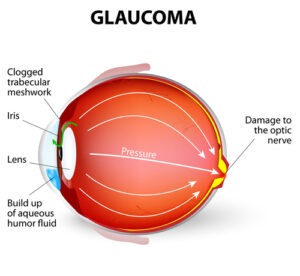Do you or someone you love have glaucoma? You’re not alone.
Millions of Americans have glaucoma, yet half of them don’t even know they have it. You may have also heard glaucoma referred to as the silent thief of sight because it typically doesn’t have any symptoms in the early stages until it’s too late.
Glaucoma results if the intraocular eye pressure rises because fluid can’t drain the way it should. When there’s too much fluid in the eye, it puts more pressure on the optic nerve, resulting in damage to it. The optic nerve connects your retina to the brain, allowing you to see. Vision loss from glaucoma is permanent. Keep reading to learn more about glaucoma and how it affects your ability to see!
Types of Glaucoma

There are several kinds of glaucoma. The two most common types of glaucoma are open-angle and angle-closure glaucoma.
Open-Angle Glaucoma
In open-angle glaucoma, the angle in your eye where the iris meets the cornea is as wide and open as it should be. However, the eye’s drainage canals become clogged over time. This causes an increase in internal eye pressure and subsequent damage to the optic nerve
Open-angle glaucoma progresses without noticeable vision loss or pain initially. Since open-angle glaucoma can occur without realizing you’ve lost any vision, it’s easy not to know you have glaucoma until irreparable damage has already happened.
By the time you start experiencing any visual symptoms, permanent damage will likely have begun. But the sooner it’s discovered after frequent testing, the sooner treatment can begin, and you can avoid the potential for future vision loss.
Angle-Closure Glaucoma
Also known as acute glaucoma, angle-closure glaucoma happens when the iris blocks the drainage angle. When this occurs, the anterior chamber becomes filled with fluid, putting pressure on your optic nerve. The result is an acute attack that’s accompanied by:
● Blurred vision
● Nausea and vomiting
● Eye pain
● Eye redness
● Intense headache
Many people develop angle-closure glaucoma without any symptoms until the attack. Angle-closure glaucoma requires immediate medical attention.
Without urgent treatment to remove the blockage, you can lose your vision permanently.
Importance of Frequent Eye Exams
Eye pressure is a significant risk factor for glaucoma. Increased eye pressure can damage the optic nerve. Since you can still develop glaucoma even if you have normal IOP, routine eye exams are important for early detection.
When left undiagnosed and untreated, glaucoma can lead to permanent vision loss. The only way to detect glaucoma early and preserve your remaining eyesight is to schedule an eye exam with your eye doctor.
Each Person is Affected Differently
For some people, increased eye pressure doesn’t damage the optic nerve for years. About a third of those diagnosed with glaucoma have what ophthalmologists regard as normal eye pressure. Glaucoma affects each person differently due to genetics.
Sixty percent of individuals affected by glaucoma have a family member with the condition. If you know someone in your family has glaucoma, it increases your risk of developing the eye condition.
Untreated Glaucoma Results in Irreversible and Total Blindness
There is no cure for glaucoma. There is no way to reverse any damage to the optic nerve that occurs once someone has glaucoma. The sooner your ophthalmologist detects the eye condition, the more successful the treatment will be.
Risk Factors for Glaucoma

Although anyone can develop glaucoma, the risk factors that increase your chances of having the condition include:
● If you’re over the age of 60
● Having a family history of glaucoma
● Suffering a severe eye injury
● Having high blood pressure
● Having diabetes
● Being extremely nearsighted
● Taking certain medications like steroids
● You’re of African American, Asian, or Hispanic descent
Detecting Glaucoma
During your comprehensive eye exam, your ophthalmologist will use the following tests to check for signs of possible problems.
● Tonometry is a test that measures your intraocular pressure with an instrument called a tonometer. The tonometer measures pressure inside the eye and can detect glaucoma
● Pachymetry measures how thick your cornea is using an ultrasonic wave instrument
● A dilated eye exam involves dilating your pupils to examine your retina and optic nerve for damage with a special kind of magnifying glass
● A gonioscopy checks the drainage angle where the iris and cornea meet
● Visual field testing examines the complete visual field and helps check to see if you’ve lost any peripheral vision
These tests help detect if you have glaucoma. From there, our team of eye doctors at Evergreen Eye Center will come up with the best treatment plan.
Glaucoma Treatment
Treatment will depend on the severity and type of glaucoma. The most common treatments for glaucoma are:
Eye Drops

After receiving a glaucoma diagnosis, eye drops to bring elevated eye pressure down are usually the first treatment used to control pressure-related glaucoma. When used exactly as prescribed, glaucoma eye drops can reduce intraocular pressure. Drop therapy can increase the outflow of the fluid, or aqueous humor, from your eye or reduce the rate fluid is produced.
Compliance is critical when using eye drops to protect your vision and slow or halt the progression of the eye condition.
Surgery
If eye drops haven’t lowered your IOP enough, or you struggle to take them every day, your eye doctor may recommend a surgical procedure. Procedures used to treat glaucoma include the following:
Trabeculectomy

A trabeculectomy is a procedure that helps lower fluid buildup in the eye, minimizing the chances of pressure damage to your optic nerve. A trabeculectomy involves creating a hole in the eye’s drainage area or meshwork to allow fluid to escape.
While a trabeculectomy can’t reverse vision loss already suffered, the surgery can control pressure, reduce reliance on drop therapy, and possibly reduce the likelihood of additional vision loss for many years in most patients.
Glaucoma Drainage Implant
If your condition is severe and other options haven’t worked, you may need a glaucoma drainage implant. A glaucoma drainage implant is surgically implanted in your eye to stabilize intraocular pressure.
The glaucoma procedure reduces the risk of more damage to your optic nerve, helping to preserve your vision. There are two types of implants: valved and non-valve.
Both have a tube and plate design where you have the tube inserted between your cornea and iris. Inserting the tube between the cornea and iris allows fluid to pass through into the plate, where it’s slowly absorbed into the surrounding tissue.
Choose Only the Best Glaucoma Specialists
Getting eye exams is the best way to detect glaucoma early and preserve your vision. If you have concerns about your eyes, schedule an appointment at Evergreen Eye Center today!

